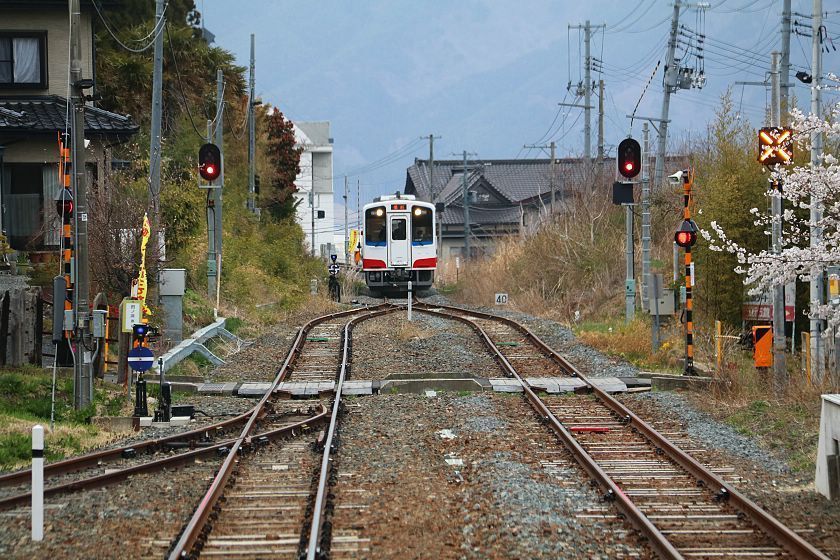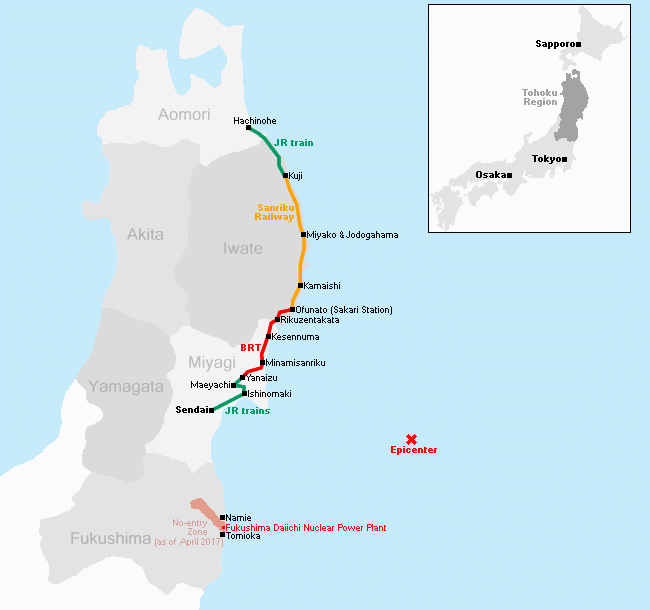Eight years after the tsunami

This is the 16th part of our open-ended series to document the recovery of the tsunami-hit coast of northeastern Japan where nearly 20,000 people lost their lives and entire towns were destroyed in the afternoon of March 11, 2011. Eight years after the tsunami, we revisited some of the worst-hit cities along the Sanriku Coast in Miyagi and Iwate prefectures on April 18-20, 2019.
For the first time, we exclusively used public transportation to travel along the coast. In March 2019, trains finally resumed operation between Miyako and Kamaishi, eight years after the section had been badly damaged by the tsunami. This now makes it possible to travel along the entire coast by train and BRT (bus rapid transit). BRT are buses that partially use former railway tracks that JR deemed too expensive to rebuild as train lines.

While comfortable and easy to use, the trains and buses along the coast are not the fastest nor the most frequent, and transfers are often badly timed. But it was exactly this forced slow-down that made this trip particularly attractive and memorable. Along the way, we witnessed the badly damaged city centers getting ready to become city centers again and were impressed by a first museum that opened about the disaster. Several more museums and memorial parks are scheduled to open in the coming months.

Day 1: Sendai to Kesennuma
08:20 depart Sendai by JR Tohoku-Senseki Line
09:20 arrive Ishinomaki
Ishinomaki is the home town of one of Japan's most influential manga artists, Ishinomori Shotaro (1938-1998), best known for Cyborg 009 and Kamen Rider. Not only is there an attractive museum devoted to Ishinomori, but the streets of Ishinomaki are scattered with statues depicting characters from his popular works. Walking past some of these statues, we made our way to the hilltop Hiyoriyama Park, a 30 minute walk from the station, from where we inspected the city's coastal districts that were particularly badly hit by the tsunami.








Compare: Apr 2019 - Apr 2018 - Apr 2017 - May 2016 - Apr 2014 - Apr 2012 - Apr 2011

Compare: Apr 2019 - Apr 2018 - Apr 2017 - May 2016 - Nov 2015 - Apr 2014 - Apr 2012 - Oct 2011 - Apr 2011

Compare: Apr 2019 - Oct 2018 - Apr 2011

At the base of Hiyoriyama Park we visited Genki Market, a new public market located attractively along the river, just a short walk from the Ishinomori Manga Museum. Various seafood and other local products are on sale at the market, and we enjoyed a wonderful lunch of sea urchin (uni) spaghetti in the food court on the second floor where many other dishes, including seafood donburi, are also available.





11:52 depart Ishinomaki by JR Ishinomaki Line
12:14 arrive Maeyachi
13:01 depart Maeyachi by JR Kesennuma Line
13:23 arrive Yanaizu
A ten minute walk from Genki Market got us back to Ishinomaki Station where we boarded our 2-car diesel train to Maeyachi Station through beautiful rural landscapes. Despite being a transfer station where the Kesennuma Line branches off the Ishinomaki Line, Maeyachi Station is rather small and surrounded by a calm, rural village. The station provided a peaceful venue for our 45 minute transfer. The next leg was by a 1-car diesel train along the Kesennuma Line to Yanaizu. We were the only ones on board.






13:36 depart Yanaizu by JR Kesennuma Line (BRT)
14:04 arrive Shizugawa
Instead of repairing some of the badly damaged coastal train lines, JR East converted some sections of the former train tracks between Yanaizu and Sakari stations into paved roads for exclusive use by buses in a system named BRT or bus rapid transit. Our first BRT ride took us from Yanaizu to Shizugawa, the central bus stop in Minamisanriku where we made a one hour stop-over.




On a circular walk, we inspected recent development in Minamisanriku's former town center which had been almost completely destroyed eight years ago. Work is ongoing on a memorial park around the former Crisis Management Center building that is scheduled to partially open in December 2019 and fully in September 2020.



Compare: Apr 2019 - Oct 2018 - Apr 2018

15:24 depart Shizugawa by JR Kesennuma Line (BRT)
16:22 arrive Oyakaigan
After our walk around the town, we continued our journey by BRT to the Oyakaigan bus stop where our lodging for the first night was located. Our hotel, the Hamanasu Kaiyokan, stood right next to the coast, providing beautiful views onto the Pacific Ocean and meals that made good use of the harvests from the local waters.







Day 2
08:49 depart Oyakaigan by JR Kesennuma Line (BRT)
08:56 arrive Rikuzen-Hashikami
One of the highlights of our journey was certainly our visit to the former Kesennuma Koyo High School in the outskirts of Kesennuma, a 20 minute walk from the Rikuzen-Hashikami bus stop. The high school was hit and damaged by the tsunami in 2011 and opened to the public only a few weeks ago as an excellent museum.






The visit to the museum starts with a 20 minute video that recalls the horrors of March 11, 2011. Afterwards, visitors enter the former school buildings which have been preserved in the state they were left by the tsunami. The museum is very well done and does a great job at keeping the memories about the disaster alive while conveying the lessons to be learnt. All students and teachers who were at the school at the time of the earthquake survived the tsunami.





11:08 depart Rikuzen-Hashikami by JR Kesennuma Line (BRT)
11:32 arrive Kesennuma
11:55 depart Kesennuma by JR Ofunato Line (BRT)
12:24 arrive Kiseki no Ipponmatsu
Back at Rikuzen-Hashikami, we continued by BRT to Kesennuma and transferred to the other BRT line that continues from Kesennuma to Ofunato's Sakari Station. Unfortunately, we had no time to see central Kesennuma this time.

Our next stop-over was in Rikuzentakata. We got off the Kiseki no Ipponmatsu bus stop near the Miracle Pine and inspected from the outside the "Iwate Tsunami Memorial", a large complex that is scheduled to open in September of this year. We then walked 20 minutes to the Rikuzentakata bus stop in the former city center which apart from the Abasse Takata shopping mall has become surrounded by many vacant residential lots ready to be built upon.








13:43 Rikuzentakata by JR Ofunato Line (BRT)
14:30 arrive Sakari
We continued from Rikuzentakata by BRT to its terminal stop Sakari where we had another 50 minute transfer. From here, our long journey along the Sanriku Railway, which I had been particularly looking forward to, would finally start.


15:20 depart Sakari by Sanriku Railway
17:50 arrive Miyako
On March 28, 2019, the heavily damaged railway section between Kamaishi and Miyako was finally reopened after eight years of disruption. Operation of the section was transferred from JR East to Sanriku Railway which had already operated lines south of Kamaishi and north of Miyako. The resulting entire line now stretches 200 kilometers along the coast from Sakari to Kuji and is not only famous for its nice scenery, but also gained popularity in the 2013 NHK morning drama Amachan.
Tucking along the coast in a single diesel car, I fully enjoyed the relaxed journey further north until our arrival at Miyako Station. From there, a shuttle bus brought us to my favorite hotel in the region, the Jodogahama Park Hotel, where we spent a tranquil night along the pine-clad coast.












Day 3
Before resuming our train trip to Hachinohe, we took an early morning walk around the wonderful Jodogahama Beach. Besides many spring flowers dotting the coastal forests, we also enjoyed a grove of rare cherry tree varieties and even encountered a family of kamoshika, goat-antelopes, native to Japan's forests. Few areas in the world have a more calming effect on me than Jodogahama, and I am already looking forward to future visits.










Compare: Apr 2019 - Apr 2018 - Oct 2017 - Oct 2016 - May 2016 - Nov 2015 - Apr 2014 - Oct 2013 - Apr 2011

09:23 depart Miyako by Sanriku Railway
11:07 arrive Kuji
The last third of the journey along the Sanriku Railway was particularly scenic, with nice views of the ocean between the many tunnels and rural inland views. In Kuji, we had another two hour transfer which we used to enjoy a sushi lunch near the station.








12:57 depart Kuji by JR Hachinohe Line
14:43 arrive Hachinohe
The final railway section along the Sanriku Coast from Kuji to Hachinohe Station by the JR Hachinohe Line was also the most scenic one, as the train followed long distances near the coast, sometimes directly next to the water. At Hachinohe, our wonderfully slow-paced trip along the coast came to an end as we transferred to the shinkansen that brought us home at speeds of up to 320 km/h.










































